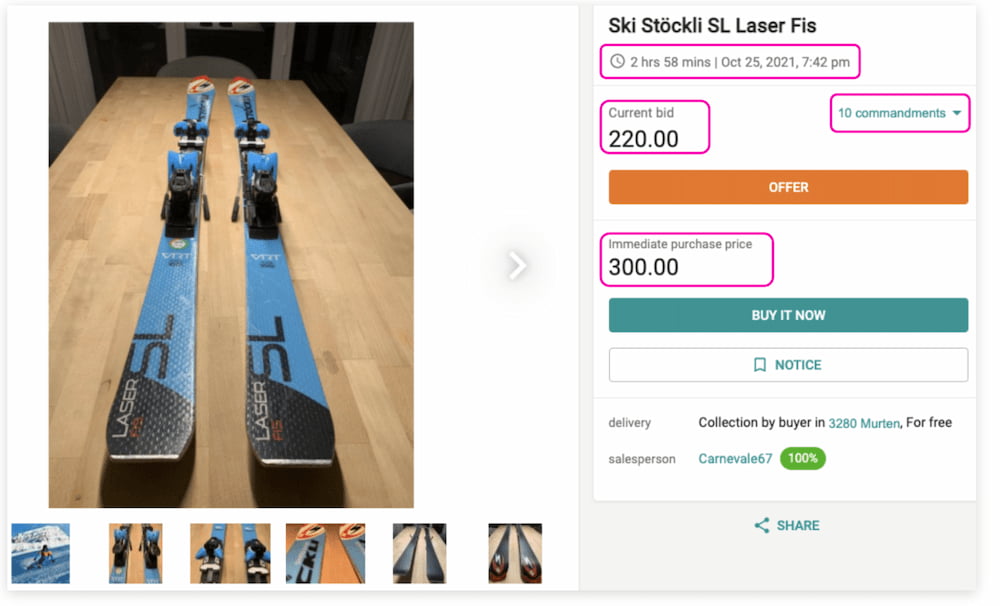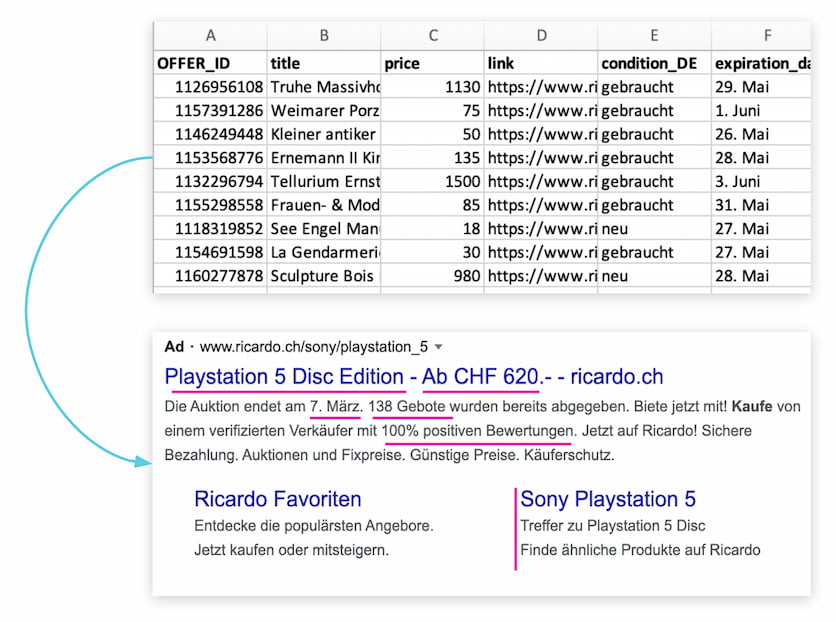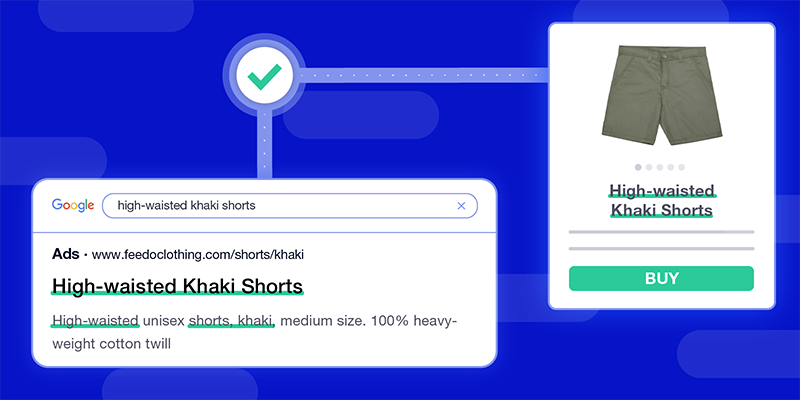Imagine you work for an online retailer and you want to make sure all of your products are being advertised on Google. Google Shopping is probably the first thing that comes to your mind. But what if you want to go beyond that? What if, for any reason, you are not eligible to advertise on Google Shopping?
Then the answer is Google inventory campaigns.
What are Google inventory campaigns?
Inventory campaigns are advanced, feed-driven search ads provided by Google. As of May 2022, they are only available on Google Search Ads 360 (SA360), the enterprise version of the more common Google Ads platform.
With inventory campaigns, advertisers can upload a product feed onto SA360 and use a set of rules and templates to create hundreds of thousands of search ads automatically.
Each search ad can show product-specific information taken from the feed. For example, it is possible to show a product’s real-time price, real-time availability, or even the units sold this week so far.
Similar to Google Shopping, inventory campaigns are ideal for advertising individual products with ads that direct to individual product detail pages. You can also use them to advertise product category pages. For example, marketers might want to show category-specific information in their ads, like the number of available products in a category, the price range, the number of products released in the past week, and more.

Why Google inventory campaigns are so relevant
Inventory campaigns are similar to Google Shopping campaigns, but have several distinct advantages:
- They are more flexible.
You have full control over the rules and templates used to create the ad copy. The ads can look exactly as you want, unlike product listing ads (PLAs) from Google Shopping that follow a given template. Also, as mentioned previously, you can point ads at category pages and not only at product detail pages. - They are not subject to the strict Google Shopping policies.
Inventory campaigns generate normal Google search ads and follow the same policies. The worst that can happen is that some ads get disapproved, but you will never incur the whole Google Merchant Center (GMC) account suspension that many advertisers fear. - They are not just for online retail. They can be used in many other industries, like hotels, flights, real estate, insurance comparison, and so on.
- They provide you with additional SERP real estate. Even if you advertise on Google Shopping already and your PLAs are strong, you don’t want your competitors to claim the top search results. Using inventory campaigns and Google Shopping campaigns together secures maximum exposure and reach.
Inventory campaigns for classifieds and marketplaces
As mentioned, inventory campaigns are not just for retail.
In particular, I believe they are very strong for general classified and marketplace businesses, such as second-hand product marketplaces, cars and vehicles, real estate platforms, general classifieds, and so on.
These businesses are generally not allowed to advertise on Google Shopping in most countries, making inventory campaigns their sole, feed-driven ads option.
These platforms advertise hundreds of thousands of products or listings, sometimes across very different categories or locations. For example, a second-hand marketplace might list anything from cheap kids’ guitars to luxury sports cars.
Making sure the inventory is fully visible and advertised on Google is extremely important, but it’s not a task that should be carried out manually. That is where inventory campaigns come into play.
Inventory campaigns offer custom rules and templates that allow marketers to fix the inconsistent quality of listing data, which is often uploaded by entry-level users who don’t fully understand the requirements and best practices.
How Feedonomics integrates with Google inventory campaigns
Inventory campaigns need a product feed to work. The feed has to be imported into SA360, either directly or via Google Merchant Center. For businesses that are not eligible for Google Shopping and don’t use GMC, the direct upload is the only option. That is where Feedonomics becomes essential.
Even with the flexibility of inventory campaigns’ rules and templates, uploading a good quality feed is by far the most important step. Without a well-optimised source feed, inventory campaigns would fail.
Google inventory campaigns + Feedonomics: case study for SMG Swiss Marketplace Group
SMG Swiss Marketplace Group owns and manages the most popular classified and marketplace websites in Switzerland. From second-hand products to real estate and cars, SMG covers several verticals.
Feedonomics has been a longstanding partner of ours, helping us manage product feeds across tens of verticals and websites.
The latest success in our partnership story is inventory campaigns for Ricardo.ch, one of SMG’s most successful brands.
The Opportunity
In late 2020, we realised that users coming from Google and landing on product detail pages (example) were eventually generating higher revenue than the ones landing on category pages (example). We spotted an opportunity: double down on advertising product detail pages on Google and maximise revenue.

The Problem
Google Shopping would have been the perfect solution for pursuing this opportunity, but Ricardo was not eligible for Google Shopping because of some policy issues. Therefore, we had to think of another viable option.
The Solution
Google inventory campaigns proved to be the perfect solution to the problem and an excellent way to pursue the revenue opportunity mentioned earlier.
Step 1: Creating the source feed with Feedonomics
The first step was to create the source feed using Feedonomics. Thanks to its advanced feed transformers and filters, we were able to make product data consistent across different categories and make the listings Google-friendly.
Also, the Feedonomics team helped us deduplicate our feed to only contain one product per category. Why did we do this?
Being a second-hand marketplace, Ricardo lists several of the same products, just from different sellers. For example, at any given moment, there are tens of PlayStation 5 listings, posted by different sellers. Assuming that users search for just “PlayStation 5” on Google, we had to show only one PlayStation 5 ad against this search.
So, which PlayStation 5 listing should we advertise? Thanks to Feedonomics, we could filter in only the listing that had the most views across the whole PlayStation 5 category.
This mechanism made sure we always advertised the most relevant listing for any given search query.
Step 2: Uploading the feed to SA360 and setting the “multipliers”
Once the feed was ready in Feedonomics, we could upload it onto SA360. The next step was to set the “multipliers.”
In SA360, a “multiplier” is a feed column that is used to split campaigns and ad groups. For example, you can use the product main category to split campaigns and the product subcategory to split ad groups. The system then creates one campaign for each main category and one ad group per subcategory.
Step 3: Creating the ad template
Once we set the multipliers, we could start working on the ad templates.
SA360 lets you create a custom template that matches feed values with ad headlines and descriptions. For example, you can set headline one to be the product title and headline two to be the product price. You can use a mix of dynamic values from the feed and static values.

The Outcome
We were able to create very customised search ads that showed listing-specific information like the product title, real-time price, number of bids already made (Ricardo is an auction-based marketplace), ending date of the auction, number of product reviews, and much more.
Inventory campaigns also proved extremely successful in terms of revenue and ROAS. In fact, they achieved a 29% increase in ROAS compared to other non-brand search campaigns for the period September 2021 through October 2021.

Giacomo Iotti is an experienced B2C Digital Marketing Manager specialising in performance marketing, ecommerce and web analytics. Currently, he lives in Zurich and works for SMG Swiss Marketplace Group, the leading marketplace and classifieds group in Switzerland. In particular, he brings his expertise to popular platforms like Ricardo.ch, Homegate.ch, Immoscout24.ch and other brands within the group. When he’s not in the office, he likes to play music, ski in beautiful Swiss mountains and regularly post on LinkedIn about #businessnews, #digital and #work.
https://www.linkedin.com/in/giacomoiotti/
https://www.giacomoiotti.me/




